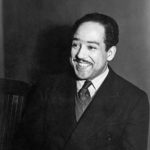 Langston Hughes was one of Frances’ close friends when she was young. At Karamu House in Cleveland, Frances worked with him and Zell Ingram. According to Frances, the three of them were like sister and brothers going on hikes, picnics and cook-outs together. And when Hughes decided to go to Cuba and Haiti, he asked Frances and Zell to accompany him. As she was still a teenager, her family dissuaded her. He and Zell went as he chronicled in his autobiography, The Big Sea.
Langston Hughes was one of Frances’ close friends when she was young. At Karamu House in Cleveland, Frances worked with him and Zell Ingram. According to Frances, the three of them were like sister and brothers going on hikes, picnics and cook-outs together. And when Hughes decided to go to Cuba and Haiti, he asked Frances and Zell to accompany him. As she was still a teenager, her family dissuaded her. He and Zell went as he chronicled in his autobiography, The Big Sea.
James Langston Hughes, writer, poet, playwright, novelist, was born Feb. 1, 1902 in Joplin, Missouri. The family moved to Cleveland where Hughes completed his high school education. While in high school, he began to develop his literary talent writing for the Central High monthly magazine and publishing his first poem.
In 1921, Hughes attended Columbia University in New York. One of his early poems, “The Negro Speaks of Rivers,” was published in 1921 in Crisis Magazine, edited by W.EB. DuBois. His poem “The Weary Blues” which won first prize in a contest and was published in 1926 in Opportunity Magazine launched his literary career.
Hughes traveled abroad extensively. He worked on a freighter down the west coast of Africa. In 1924 he lived several months in Paris, France, and from 1932-1933 along with a group of African American artists, he visited the Soviet Union.
A prolific writer, Hughes wrote two autobiographies, The Big Sea (1940), and I Wonder as I Wander (1956), several volumes of poetry, novels, plays, essays and a dozen children’s books. His work celebrated black life and culture infusing them with a strong sense of racial pride. His first novel, Not Without Laughter, (1930) won the Harmon Gold Medal for Literature.
In 1942 and continuing for twenty years, he wrote a column for the Chicago Defender newspaper featuring the character Jesse B. Simple. Simple, representing the common black man in Harlem, commented on matters mainly about race and racism culminating in a collection of essays entitled, “Simple Speaks His Mind.”
He experimented with free verse and infused his poems with the rhythms of jazz and blues. In his noteworthy essay “The Negro Artist and the Racial Mountain” Hughes affirms the role of the Negro artist. “We younger Negro artists who create now intend to express our individual dark-skinned selves without fear or shame. If white people are please, we are glad. If not, it doesn’t matter. We know we are beautiful and ugly, too.”
On May 22, 1967, Hughes died at age 65 from complications after abdominal surgery.
.